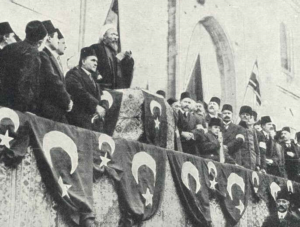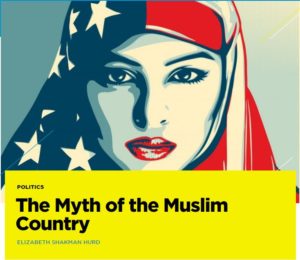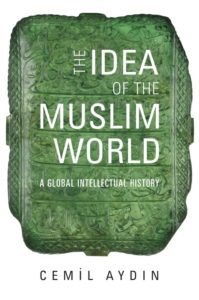 Recently, a friend of mine originally from Calcutta was outside his house gardening on a Sunday morning when a neighbor came by and asked, “How was church this morning?” “I didn’t go to church,” he replied, “I’m Hindu.” “I’m sorry,” she responded. Another day, also while gardening, a different neighbor approached to ask how much my friend charges for landscaping. He explained that he owns the house.
Recently, a friend of mine originally from Calcutta was outside his house gardening on a Sunday morning when a neighbor came by and asked, “How was church this morning?” “I didn’t go to church,” he replied, “I’m Hindu.” “I’m sorry,” she responded. Another day, also while gardening, a different neighbor approached to ask how much my friend charges for landscaping. He explained that he owns the house.
We live in a moment in which for some Americans, to be perceived as Muslim, dark-skinned, and/or non-Christian, generates confusion and, at times, hostility. This is not new. Efforts to grapple with the fraught intersections of race, religion, and power are ubiquitous. An interesting corollary of this suspicion is the conviction that one’s religious affiliation influences or determines one’s national loyalties and political preferences. The habits involved in drawing these connections are complex and, I suspect, difficult to unlearn.
Cemil Aydın’s exceptional new book is a great place to begin. In this response, I focus on the implications of Aydın’s critique of the idea of the Muslim world for the study of global politics and religion. His work is a crucial part of the backstory to my recent work on the politics of international efforts to identify and protect religious individuals and communities as objects of law and governance. These deeply politicized efforts rely on and also help produce the essentialized notion of the Muslim world that Aydın interrogates. The stabilization and reification of Islam and other so-called world religions that I have remarked on in the theory and practice of international relations make The Idea of the Muslim World not only academically prescient but politically necessary. It allows us to reevaluate, and perhaps unlearn, some of the powerful yet nearly imperceptible assumptions about religion and politics that inhabit us as moderns.
An example: The idea of the Muslim world enables narratives in which Islam “causes” people to do things. It allows for the depiction of Islam as the religion that is most recalcitrant and resistant to Western-style modernity, an agent that defines all aspects of life. Like other religions, only more so, the “Muslim world” requires management with white gloves, and sometimes the use of force, to prevent it from igniting into violence.
This narrative requires certain preconditions to take root and flourish. It needs stable entities called “religions” that are taken for granted as drivers of (peaceful or violent) forms of politics, (amenable or hostile) social relations, and (oppressive or emancipatory) legal and social systems. It is in this environment that something called “Islam” can be successfully portrayed as a “cause” of violence. It is in this environment that Ted Cruz’s preposterous assertion during the presidential campaign that “there is no meaningful risk of Christians committing acts of terror” could be a plausible statement to more than a few supporters.
Asserting the capacity of religion to determine political behavior (or misbehavior) as Cruz does distorts the complex realities of human social life. These are however powerful political gestures whose cumulative effect is to create social and political worlds that are saturated with naturalized distinctions and suspicions between Muslims (and other religions/races) and others. As Talal Asad explains:
The construct of religion itself allows outsiders to attribute beliefs, practices, and attitudes to other traditions (yes, that is their religion, and that is why all its believers are our enemies). In the Schmittian politics thus generated, friends are essentially those who share one’s enmity towards defined others. The aim of this politics is to defeat the enemy and eliminate or convert him to “real” orthodoxy and orthopraxy—whether inspired by divinity or by humanity.
 Where does this leave us? Picking up where I left off in “The Myth of the Muslim Country,” let us look at the narrative of Muslims as naturally violent. This idea draws sustenance from a much broader and deeper well than is acknowledged by most critics of far-right anti-Muslim politics. While it enjoys strong support from white nationalists and supremacists, it also has the tacit support of other constituencies, including many liberal internationalists who would otherwise disassociate themselves from white supremacist politics or anti-Muslim animus.
Where does this leave us? Picking up where I left off in “The Myth of the Muslim Country,” let us look at the narrative of Muslims as naturally violent. This idea draws sustenance from a much broader and deeper well than is acknowledged by most critics of far-right anti-Muslim politics. While it enjoys strong support from white nationalists and supremacists, it also has the tacit support of other constituencies, including many liberal internationalists who would otherwise disassociate themselves from white supremacist politics or anti-Muslim animus.
In Boston Review I made but did not explore in depth the claim that the heightened politicization and demonization of Muslim difference domestically in the United States should be understood not only in light of the recent presidential election but also as related in subtle but sustained ways to a series of legal and political initiatives that have politicized religious difference nationally and internationally for decades. These include international instruments such as the Genocide Convention and other human rights guarantees implicating religion, as well as a range of efforts to constitutionalize religion and promote religious freedom, guarantee the rights of religious minorities, and produce tolerant religio-political subjects (today flying under the flag of “countering violent extremism”). These efforts have intensified in recent decades as a result of the emergence of a global “religion agenda” that is shaping foreign and international public policy, as discussed in Beyond Religious Freedom.
Aydın’s book helps us understand how these forms of politics became possible. The idea of the Muslim world enables the specific forms of politics and religion that structure contemporary international relations, many of which are premised on the protection of individuals and groups on the basis of religion. This is why his book is so important. If we were to take Aydın’s thesis to heart, programs to cultivate tolerant Muslims and suppress Islamic extremism that are premised on the notion of a stable “moderate” Muslim identity would be unimaginable. Instead policymakers would have to contemplate a much broader and more complex set of factors and forces, as Alireza Doostdar, Darryl Li, and Jamie Allinson have done in the case of ISIL.
Human rights instruments that treat individuals primarily as carriers of an ethnic or religious identity would also have to be reconsidered, inasmuch as they presume the existence of the very Muslim world (and Christian world, Hindu world . . .) that Aydın historicizes. As I discussed in Boston Review, an example is the notion of “religion” that animates official declarations of genocide. Genocide is a special category of international crime, defined in the 1948 Convention as systematic killing or atrocities “committed with intent to destroy, in whole or in part, a national, ethnical, racial or religious group.” The Convention puts a word to an act: The mass extermination of identifiable communities will henceforth be called “genocide.” The term speaks in the language of race, religion, and ethnicity—mass killings of political opponents do not count as genocide. As Aydın shows, however, “Muslim” as a politically salient ethnic, religious, and/or racial identity is the product of political and religious discourse and history.
This is evident in Bosnia, where historians have traced a distinctive genealogy of the category “Muslim” that involves its incremental attachment to the idea of ethnicity and its increasing significance as a presumed indicator of political allegiance leading up to the Bosnian War. David Campbell notes that in the 1990s, Bosnians who saw themselves as atheists before the war woke up to find themselves identified—and divided—by a newly salient religious identity. In a footnote (which contains the puzzle of a book waiting to be written) to a review essay on narratives of the war, Campbell describes the politicization of the category:
According to Borden, though there had been a category of ‘Muslims ethnically undeclared’ prior to 1961, the revision of that year made the significant categorical switch to ‘Muslims in the ethnic sense.’ This transformation of the census then culminated in 1971 with the category ‘Muslim’ being a distinct and equal nationality . . .”
In Yugoslavia: Death of a Nation, Laura Silber and Allan Little suggest that the nationalization of “Muslim” was in fact not complete until the 1974 constitution.
In order to have “religious” genocide, whether perpetrated against or by a collectivity known as Muslims, there needs to be a recognizable “something” that is identified as Muslim. That “something” is variously created, cemented, disseminated, legalized, contested, and changed through various forms of law, through linguistic, literary, and religious practices, administrative procedures, media discourse, visual and artistic representations, and so on. This unfolds differently in different times and places, and it is a global, and deeply politicized, process. Aydın demonstrates that pan-Islamism—the idea that there is such a thing as a “Muslim world”—is a new and historically strange invention, a legacy of imperial racism. While delicately managing to avoid essentializing a construct that he himself employs (no easy task!), Aydın refers to the notion that there is a coherent identity of the Muslim world as “Muslim world thinking.” In his words, “the racialization of Islam was bound up with its transformation into a universal and uniform religious tradition, a force in international politics, and a distinct object in a discourse of civilizations. Political strategy and intellectual labor made this new reality, and both Muslims and European Christians took part.” And off we go. It is only a matter of time until we have legal instruments producing, defining and protecting religions.
 Chapter 3 tells the story of how this “imagined unified Muslim world” came into being. It describes the consolidation of the notion of “Islamic civilization”; the emergence of a novel conception of Islam as a universal religion that could dispute the claims of both Christian missionaries and secular Orientalists, alongside what came to be seen as Enlightened or tolerant Islam, or Islamic modernism; new interpretations of Muslim history as a product of Western humiliation; a new historical consciousness positing eternal conflict between the Muslim world and the Christian West; growing awareness of the geography and demography of Muslim-majority territory; and the rise of an anticolonial internationalism embracing non-Muslim societies in Asia and Africa. “Racialized Muslim subjects,” Aydın concludes in a key passage, “remained the real heart and animating force of pan-Islamism.” It is this perception of solidarity—a particular and historically contingent species of racialized colonial and postcolonial solidarity—that mattered, and that still does. Our task as scholars, then, is no less than to debunk the epistemological and political assumptions of racialized Muslim-world unity:
Chapter 3 tells the story of how this “imagined unified Muslim world” came into being. It describes the consolidation of the notion of “Islamic civilization”; the emergence of a novel conception of Islam as a universal religion that could dispute the claims of both Christian missionaries and secular Orientalists, alongside what came to be seen as Enlightened or tolerant Islam, or Islamic modernism; new interpretations of Muslim history as a product of Western humiliation; a new historical consciousness positing eternal conflict between the Muslim world and the Christian West; growing awareness of the geography and demography of Muslim-majority territory; and the rise of an anticolonial internationalism embracing non-Muslim societies in Asia and Africa. “Racialized Muslim subjects,” Aydın concludes in a key passage, “remained the real heart and animating force of pan-Islamism.” It is this perception of solidarity—a particular and historically contingent species of racialized colonial and postcolonial solidarity—that mattered, and that still does. Our task as scholars, then, is no less than to debunk the epistemological and political assumptions of racialized Muslim-world unity:
Countering essentialism demands engagement with history, specifically how the discriminatory and racialized governing practices of European empires collectivized the political struggles and destinies of societies where Muslims lived in large numbers. At the turn of the twentieth century, being Muslim in India, West Africa, Central Asia, or Southeast Asia had racial connotations. The Muslim world partly constituted by these regions was therefore seen as a rival of and sometimes a threat to white supremacy. Under such conditions, Muslim humiliation at the hands of the West emerged as the shared history of Muslim societies, whether under Christian imperial rule or observing the effects of that rule from within Ottoman domains. The narrative of eternal conflict between the Muslim world and the West originated in the late nineteenth century, yet non-Muslims and Muslims alike assumed that this narrative reflected a historical reality prevailing since the seventh century . . . Today’s counternarratives against the essentialization of Islam and the Muslim world must account for the historical context that produced the conditions and content of that essentialization.
This is a tall order. Fortunately Aydın is not alone: Iza Hussin’s The Politics of Islamic Law, Nadia Marzouki’s Islam: An American Religion, Noah Salomon’s For Love of the Prophet, and Brannon Ingram’s forthcoming Revival from Below: The Deoband Movement and Global Islam all, in different ways, help accomplish this Herculean task.
The historical context to which Aydın refers allows for the essentialization of Islam and other “world religions.” He is right that these contexts deserve more critical attention, not only because of the pernicious consequences of the imagined unity of the Muslim world but also because of the political dangers and social damage wrought by the intense—and arguably intensifying—politicization of the world religions framework. The drive to isolate and privilege religion as a cohesive social force that can be detached from its local environment is a political gesture and a distinctive form of (secularist) politics. It renders unimaginable collective modes of being, belonging and acting that escape the secular-religious binary. It diminishes the prospects for crosscutting, nonsectarian forms of solidarity. And it blinds to us to the complex politics within traditions, as Jeremy Walton shows in his compelling analysis of Turkish Sunni Muslim civil society actors whose neo-Ottoman spatial practices challenge Kemalist sovereignty over Islam and its strict distinction between political and religious spaces and places.
We should know this now. But the implications of this approach, while receiving ample airtime on The Immanent Frame, have yet to be internalized by those who craft policy and insist on religion as a fixed identity marker that is cleanly differentiable from—and a causal force in—world politics. The Idea of the Muslim World could not have come at a better time.












